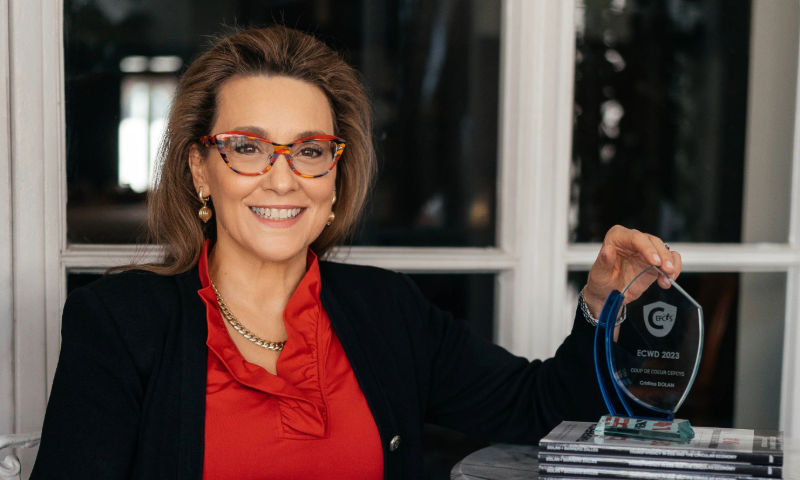Cristina Dolan is an award-winning cybersecurity executive, engineer, computer scientist, and entrepreneur, driving transformation in security, data, fintech, and telecom. She co-founded a groundbreaking cyber insurance startup, iXledger, and is an advisor and board member of several companies including WiseKey (SWX: WIHN), SEALSQ (NASDAQ:LAES), and GRIID (NEO:GRDI). Most recently, she has been the Managing Director for LatAm and Head of the Americas distribution channel, and the Head of Global Alliances for RSA NetWitness. Additum, an award-winning European health-tech company she co-founded, is utilizing value-based data to improve outcomes in Europe and Africa.
In addition to holding executive positions at Disney, IBM, Oracle, and TradingScreen, Cristina co-founded OneMain.com, which became the tenth-largest ISP after a successful IPO that surpassed Amazon’s and eBay’s respective IPO records. Her accolades include co-authoring ‘Transparency in ESG’ and launching the renowned ‘Dream It. Code it. Win it’ student coding competition, which garnered numerous honors. Recognized as the “Coup de cœur” of the CEFCYS in Europe, alongside distinctions such as 100 Women in Finance, Cristina exemplifies visionary leadership.
Recently, in an exclusive interview with Digital First Magazine, Cristina shared her career trajectory, the mission and vision of Additum, the major takeaways from her latest book, the secret mantra behind her success, future plans, words of wisdom, and much more. The following excerpts are taken from the interview.
Hi Cristina. Please tell us about your professional background and areas of expertise.
As a cybersecurity, technology, and digital transformation executive with an exciting career continually working with the most disruptive technologies to create business value, my professional journey has propelled me to the forefront of technological advancement. With degrees in electrical engineering and computer science, I have acquired a solid foundation that continually propels my learning journey. This educational background has provided me with valuable insights into the ever-evolving technical landscape. Throughout my career, I have had the privilege of working with a diverse range of disruptive technologies, from developing the first consumer websites for Disney and Heart to introducing secure e-commerce solutions at Oracle. Additionally, I have been involved in numerous entrepreneurial initiatives focused on growing and building solutions for cyber risk, cyber insurance, cybersecurity, AI, and Computational Linguistics. My experiences have also involved navigating complex challenges in data management, exploring innovative applications of blockchain technology, and engaging with transformative concepts in InsurTech, including Cyber Insurance and Cyber Risk assessment. Recently, I have been focused on Network Detection and Response solutions, as well as providing Incident Response services to customers throughout the Americas.
Throughout my career, I have had the opportunity to contribute to various aspects of business leadership, including serving as CEO of a venture-backed company and holding positions in Alliances, Channel, Sales, Technology, Software Development and Product Management. These diverse experiences have allowed me to play a part in driving success and fostering innovation across sectors such as Cloud computing, FinTech, Digital Media, InsurTech, MedTech, and Data Science.
Recently, I coauthored a book, “Transparency in ESG and the Circular Economy, Capturing Opportunities Through Data” (ESGdataBook.com), which underscores Cyber Risk as the most immediate financial material ESG and sustainability risk that organizations face today. Additionally, the second book that I co-authored, “Industry 5.0 and Data Economy,” is slated for release in 2024.
Furthermore, I currently enjoy serving as a board director on the boards of three public companies. Drawing from my breadth of experiences as an executive in Fortune 500 companies and entrepreneurial roles, I bring a nuanced understanding of innovation, digital transformation, cybersecurity, and ESG—a skill set critical for effective board governance.
What do you enjoy the most about your work in cybersecurity, cloud, and AI?
What I enjoy the most about my work in cybersecurity, cloud, and AI is the opportunity to collaborate with clients in safeguarding their crucial data and infrastructure amidst the ever-growing threats. It’s akin to solving a complex, multi-dimensional puzzle that integrates various disciplines and technologies.
Moreover, as we stand at the forefront of the next industrial revolution, the potential for AI and other data-powered technologies to significantly impact the global GDP is immense. Analysts predict that within the next five years, these technologies could contribute seven to ten percent to the global GDP. This revolution presents unprecedented opportunities, surpassing those of previous industrial revolutions in a shorter timeframe. Consequently, the exponential growth of networked data systems amplifies the value stored in data and transmitted through critical infrastructure. However, this growth also escalates cybersecurity threats, given the exponential expansion of data-driven businesses.
In the current landscape, cybersecurity stands out as the most immediate financially material sustainability and ESG risk for organizations. Its significance is heightened by its weaponization by nation-states and malicious actors, exploiting its asymmetric properties to disrupt communities by targeting critical infrastructure. As the attack surface expands due to the continuous proliferation of distributed network technologies, cybersecurity threats continue to evolve and escalate.

You are also the Co-Founder of Additum Blockchain. Can you please tell us about the mission and vision of this healthcare platform?
Additum is dedicated to revolutionizing the healthcare landscape by harnessing cutting-edge digital technologies to optimize patient outcomes. Our team comprises esteemed industry leaders hailing from diverse backgrounds, including the Ministry of Health, the Spanish Medicines Agency, various clinical areas, renowned institutions like MIT, as well as prominent companies such as Alastria, Lilly, and GE Healthcare. Notably, our CEO, Javier Colas, brings invaluable experience as the former CEO of Medtronic EMEA.
The healthcare sector holds paramount significance for several compelling reasons. Firstly, it fulfills fundamental human needs by delivering essential medical services, treatments, and preventive care, thereby enhancing the overall quality of life and extending longevity on a global scale. Secondly, healthcare serves as a linchpin for economic growth and stability, generating substantial employment opportunities across a spectrum of roles and catalyzing innovation through ongoing research and development in pharmaceuticals, medical devices, and biotechnology. Thirdly, robust healthcare systems are indispensable for societal resilience, especially in times of crises such as pandemics, natural disasters, or humanitarian emergencies.
As the healthcare industry grapples with the escalating disparity between the available healthcare workforce and the burgeoning demand for services, exacerbated by factors like pandemic-induced burnout, retirements, and work-life balance challenges, the role of data and AI-enabled technologies becomes increasingly pivotal. Addressing this gap is paramount, particularly in light of the aging population, the expanded access to care facilitated by initiatives like the Affordable Care Act, and the continuous advancements in medicine necessitating proficient personnel for administration and management.
In the absence of commensurate growth in the healthcare workforce, leveraging AI and other data-enabled technologies assumes critical importance in striving to achieve the UN Sustainable Development Goals, particularly the third goal: “Ensure healthy lives and promote well-being.”
In essence, Additum Blockchain is poised to be at the forefront of this transformative journey, spearheading innovation to enhance healthcare accessibility, efficiency, and effectiveness while advancing the broader societal goals of health and well-being.
You recently co-authored a book, Transparency in ESG and the Circular Economy, which garnered a lot of attention from industry experts and readers. Can you please brief us about the major takeaways from this book?
Beyond Decarbonization: A Broader View of ESG Risks: While ESG serves as a vital metric for gauging sustainability, its full potential remains untapped due to a limited understanding. Traditionally, ESG has been primarily associated with decarbonization, a challenge arising from the innovations that fueled the past industrial revolutions. However, the book emphasizes the need to consider a wider range of threats impacting businesses, society, and the planet.
Navigating the Labyrinth of Sustainability Reporting: The book sheds light on the various frameworks, standards, datasets, and approaches employed in sustainability reporting. It highlights the key reasons why achieving standardization, akin to bond ratings or other indexes, proves elusive in this domain.
Cybersecurity: The Looming Threat in the Age of AI: As we embark on the data-driven and AI-powered fourth industrial revolution, cybersecurity emerges as the most significant threat to sustainability. The book acknowledges the existence of diverse approaches to defining and reporting cybersecurity risks, underlining the absence of a single, unified method.
Understanding the Nuances of Sustainability: Ultimately, the book aims to equip readers with a comprehensive understanding of the diverse approaches, data elements, and perspectives used to define sustainability and ESG risks. It delves into the historical evolution of corporate social responsibility, sustainability, and ESG, emphasizing how the interpretation of these metrics can vary depending on the reporting entity, investor, or intended audience.
By fostering a deeper grasp of the factors contributing to the sustainability of organizations, communities, and the planet, the book empowers individuals to make meaningful contributions toward improving overall sustainability, starting at the local level.

Are you currently satisfied with the status quo regarding women in tech? What specific changes do you think are needed to change the status quo?
The current landscape in the tech industry presents both opportunities and challenges, particularly regarding the representation of women. While the fourth and fifth industrial revolutions hold immense potential for economic growth, it’s imperative that women are actively involved and equipped with the necessary skills to thrive in this dynamic environment. However, the reality is that women remain underrepresented in the tech sector.
According to recent statistics, women make up only around 26% of the computing workforce and hold only about 20% of tech jobs in major tech companies. This disparity underscores the need for concerted efforts to foster greater inclusion and participation of women in tech from an early age. Education plays a crucial role in this regard, and initiatives aimed at encouraging young girls to pursue STEM (Science, Technology, Engineering, and Mathematics) fields are essential.
Navigating the tech industry can be daunting, given its rapid pace of innovation and complex nature. Organizations such as CEFCYS [Le CErcle des Femmes de la CYberSécurité], led by visionaries like Dr. Nacira Guerroudji-Salvan, are instrumental in creating supportive communities where women in tech can connect, learn, and grow. Personally, I’ve had the privilege of being recognized with the “Coup de Coeur” award at the 4ème Trophée Européen de la Femme Cyber du CEFCYS in Paris, an experience that has allowed me to forge meaningful connections with inspiring women in the cybersecurity field across Europe.
To address the status quo and promote greater gender diversity in tech, several key changes are necessary. Firstly, there must be a concerted effort to challenge and dismantle gender biases and stereotypes that discourage women from pursuing careers in tech. This involves creating inclusive environments within educational institutions, workplaces, and industry events. Additionally, mentorship and sponsorship programs can play a vital role in providing support and guidance to women as they navigate their careers in tech. Furthermore, policies and initiatives aimed at promoting gender diversity and inclusion, such as flexible work arrangements and pay equity measures, are crucial for creating a level playing field for women in the tech industry.
Ultimately, achieving gender parity in tech requires a collective commitment from stakeholders across the board, including governments, educational institutions, tech companies, and individual professionals. By fostering a culture of inclusivity, providing support and resources, and actively addressing systemic barriers, we can create a tech industry that truly reflects the diverse talents and perspectives of society as a whole.
When you founded and launched the student coding competition, Dream it. Code it. Win it., was your goal to engage females so that they would pursue STEM careers?
Dream it. Code it. Win it. was originally launched through the encouragement of a number of the MIT Corporation Board Members when I was the Chair of the MIT Enterprise Forum of New York. The goal was to engage all students in STEM in a fun and engaging way, so I decided to make it a competition. Students were rewarded for solving an interesting problem utilizing technology. At the time I didn’t appreciate how difficult problem solving is. Albert Einstein allegedly said something like, ‘If I had an hour to solve a problem, I’d spend 55 minutes defining the problem and five minutes thinking about solutions.’ As an engineer, most of my friends were engineers and problem solvers and I didn’t consider problem-solving as a rare skill. Problem-solving requires the whole brain thinking. The Right Hemisphere of the brain creatively generates solutions, and the Left Hemisphere decides on the solution. The solution execution utilizes the frontal lobe which is responsible for executive function. All these processes make solving problems challenging, just defining the problem to be solved is challenging, and that is the critical first step.
While the competition wasn’t created to explicitly engage females, it was interesting to see 50% of the submissions were from females every year of the competition. What was even more surprising was the fact that many of the problems the young girls submitted had been better thought out and their solutions were complex. In addition, the descriptions of the problems that motivated the female competitors were more sophisticated. This caught my attention because the competition did not focus on specifically attracting females and yet they showed up and executed well.
Amazingly, so many young women were attracted to this problem-solving with technology competition, and yet women are not often associated with this skill set.
The career opportunities that will exist going forward will require these types of skills. The intersection of data and other disciplines, including cybersecurity, to digitally transform and power new industries. This is why it is important to understand how to make sure that women continue to be encouraged to engage in these opportunities.

In your opinion, what are the biggest challenges women face in tech that aren’t typically faced by their male counterparts? What would you suggest to address this?
When considering the challenges women encounter in the tech industry, it’s crucial to recognize the profound impact of organizational culture. Every workplace has its unique ethos, shaped by its history, values, and norms, which inevitably influences how individuals interact and collaborate within that environment. Unfortunately, the tech industry remains largely male-dominated, with its own distinct culture and communication dynamics that may not always align with those of some women.
One significant hurdle women face is the need to navigate and adapt to these existing cultural norms. Male-dominated environments often perpetuate communication styles and social dynamics that may not fully accommodate or value the contributions of women. This can create challenges in terms of building rapport, establishing credibility, and accessing opportunities for advancement.
To address this disparity, it’s essential to foster a more inclusive and supportive ecosystem within the tech industry. One approach is the establishment of industry organizations specifically geared toward supporting and empowering women across various organizations. These platforms provide invaluable networking opportunities, mentorship programs, and resources tailored to the unique needs and experiences of women in tech. By cultivating a sense of community and solidarity, these organizations play a pivotal role in helping women navigate and thrive in male-dominated environments. One example is a European organization I mentioned earlier, CEFCYS [Le CErcle des Femmes de la CYberSécurité], founded by industry luminary Dr. Nacira Guerroudji-Salvan.
Moreover, organizations that prioritize diversity and inclusion in their corporate culture and leadership initiatives stand to attract and retain top talent from diverse backgrounds. By fostering an environment where all employees feel valued, respected, and empowered to contribute their unique perspectives, organizations can create a more equitable and conducive workplace for women in tech.
Another challenge women may encounter is the pressure to stand out and assert themselves in environments where competition and comparison are prevalent. This can lead to feelings of self-doubt, imposter syndrome, or reluctance to advocate for oneself. Recognizing and addressing these psychological barriers is crucial for empowering women to assert their value and pursue opportunities for growth and advancement within the tech industry.
Ultimately, addressing the challenges women face in tech requires a multifaceted approach that encompasses both structural changes within organizations and broader cultural shifts within the industry as a whole. By fostering inclusive cultures, and providing targeted support and resources, we can create a more equitable and thriving tech ecosystem where women can fully realize their potential and contribute to innovation and success.
The meaning of leadership can change from one era to the other. How would you define the meaning of leadership today?
In today’s rapidly evolving business landscape, the definition of leadership has undergone a profound transformation. As companies embrace digitalization and innovation at an unprecedented pace, the role of a leader has evolved to meet the demands of this dynamic era.
At the heart of contemporary leadership lies agility and adaptability. Leaders must possess the ability to navigate through uncertainty and change with grace and resilience. The speed at which companies transform necessitates leaders who are not only visionary but also agile in their decision-making and strategic execution.
Moreover, the advent of new communication technologies and collaboration tools has revolutionized the way organizations operate. Leaders now have access to a myriad of communication channels and analytics tools that enable them to foster transparency, facilitate real-time feedback, and promote collaboration across geographically dispersed teams. This shift towards flatter organizational structures underscores the importance of leaders who can effectively harness these tools to foster a culture of open communication and engagement.
In today’s landscape, understanding the needs and motivations of both customers and employees is paramount. Leaders must cultivate a deep understanding of their customer base to deliver value-driven solutions and maintain a competitive edge in the market. Similarly, recognizing the intrinsic value of employees as the most valuable asset within organizations is crucial. Effective leaders prioritize the well-being and development of their teams, fostering a culture of trust, respect, and empowerment.
Furthermore, the way in which leaders communicate has also evolved significantly in recent years. Effective communication is no longer confined to traditional channels but encompasses a diverse range of mediums, from virtual meetings and social media platforms to immersive digital experiences. Leaders must be adept at leveraging these communication tools to inspire, motivate, and align their teams towards common goals.
In essence, the meaning of leadership today is characterized by agility, empathy, and digital fluency. Successful leaders embrace change, empower their teams, and leverage technology to drive innovation and organizational excellence in an increasingly complex and interconnected world.

In your academic or work career, were there any mentors who have helped you grow along the way? What’s the best piece of advice you have ever received?
Throughout my academic and professional journey, I’ve been fortunate to have had exceptional mentors who have played pivotal roles in my growth and development. These mentors have been instrumental not only in providing guidance and support but also in imparting invaluable wisdom that has shaped my approach to both my career and personal pursuits.
Drawing parallels between sports and the corporate world, I’ve found that the lessons learned on the field often translate seamlessly into the boardroom. As an elite athlete, I’ve experienced firsthand the importance of resilience, determination, and teamwork – qualities that are equally essential for success in the professional realm. Indeed, women who participate in competitive sports often bring a heightened sense of competitiveness and drive to their professional endeavors.
One of the most impactful pieces of advice I’ve received from a mentor is the importance of effective communication, particularly public speaking. The ability to articulate ideas, influence others, and command attention is a skill that transcends industries and roles. Mastering the art of public speaking has not only bolstered my confidence but has also opened doors to countless opportunities for growth and advancement.
In turn, as a mentor myself, I’ve had the privilege of guiding and supporting numerous students and young professionals on their journeys. One common misconception I’ve observed among mentees is the expectation that a mentor’s role extends beyond providing guidance and advice. While mentorship undoubtedly involves fostering professional growth and offering insights, it’s essential for mentees to proactively engage with their mentors and take ownership of their own development.
It’s crucial for mentees to recognize that the onus is on them to translate advice into action and leverage their mentor’s guidance to propel their careers forward. Rather than viewing mentors as conduits for continuous business development or fundraising, mentees should approach mentorship as an opportunity for learning, growth, and self-discovery.
In essence, mentorship is a reciprocal relationship built on mutual trust, respect, and commitment to personal and professional development. By actively engaging with mentors, seeking out opportunities for growth, and applying the wisdom gleaned from their guidance, mentees can unlock their full potential and chart a course for success in both their careers and lives.
Over the years, you have been a recipient of numerous honors including: 100 Women in Finance; Women to Watch in Crypto and Blockchain; 100 Most Influential Blockchain Women; and Thought Leader in Crypto and Blockchain to name a few. Our readers would love to know the secret mantra behind your success.
I’ve been deeply humbled and honored to receive recognition for both my professional endeavors and my contributions to various causes close to my heart. These accolades serve as a testament to the dedication and passion I’ve poured into my work, as well as the meaningful connections I’ve forged within my academic and professional communities. Speaking multiple languages has enabled me to connect with peers all over the world and engage with many well-respected global professional communities.
Some of these honors stem from my longstanding engagement with esteemed institutions such as MIT and Convent of the Sacred Heart in Greenwich, where I’ve had the privilege of contributing to and learning from vibrant academic environments. Others have been bestowed upon me by respected industry organizations with whom I’ve collaborated closely over the years, fostering meaningful relationships and driving impactful initiatives.
For me, the key to success lies in pursuing work that ignites a genuine sense of passion and purpose. When you wholeheartedly love what you do and the industry you serve, achieving recognition becomes a natural byproduct of your dedication and commitment. Throughout my journey, I’ve remained steadfast in setting ambitious goals and staying laser-focused on realizing them.
However, success isn’t solely defined by reaching predetermined milestones; it’s about embracing the inevitable twists and turns along the way with resilience and determination. Challenges and setbacks are an integral part of the journey, and it’s how we navigate and overcome them that truly defines our growth and accomplishments. Every obstacle surmounted, every lesson learned, contributes to the richness and depth of the journey, making the ultimate achievement all the more meaningful.
In essence, my mantra for success revolves around passion, perseverance, and a steadfast commitment to continuous growth and learning. By embracing challenges as opportunities for growth and remaining unwavering in my pursuit of excellence, I’ve been able to carve out a fulfilling and impactful career journey—one marked by both professional achievements and personal fulfillment.

Where would you like to be in the next 5 years?
In the next five years, I envision myself continuing to play a multifaceted role as an executive, entrepreneur, and board member, collaborating with forward-thinking organizations at the forefront of data and digital transformation. As we navigate the Fourth Industrial Revolution, I see unparalleled opportunities emerging across various industries, driven by advancements in technology and the proliferation of data-driven insights through Artificial Intelligence.
One area that particularly captivates my attention is cybersecurity—a critical concern that will only become more pronounced as organizations increasingly rely on digital infrastructure. In the face of evolving threats, my focus will be on partnering with clients to develop robust solutions that safeguard their operations against cyber risks, thereby fortifying their resilience in an ever-changing landscape.
Moreover, as a mother to two remarkable sons embarking on their own journeys in computer engineering and computer science, I eagerly anticipate witnessing their contributions to this transformative era. It’s a source of immense pride and joy to see them poised to make meaningful impacts in an industry that holds the potential to shape the future in profound ways.
In essence, my aspirations for the next five years revolve around leveraging my expertise and passion to drive positive change, both professionally and personally. By embracing the opportunities presented by the digital age and nurturing the next generation of innovators, I aim to leave a lasting legacy that transcends boundaries and empowers individuals and organizations to thrive in an increasingly interconnected world.
What advice would you give to women who want to enter the tech industry?
For women aspiring to break into the tech industry, my advice is to embrace your ambition without reservation and refuse to be deterred by naysayers or self-doubt. Throughout my own journey, I’ve encountered countless instances where I was met with skepticism or discouragement, with people questioning whether I truly belonged in certain roles or industries. However, I refused to let these doubts define me or limit my aspirations.
It’s important to recognize that feelings of inadequacy or impostor syndrome are not unique to any one individual—they are common experiences shared by many successful professionals, regardless of gender. Instead of allowing these doubts to derail your ambitions, use them as fuel to propel yourself forward. Let them serve as reminders of the resilience and determination required to achieve your goals.
Moreover, in an era characterized by rapid technological advancements and constant disruption, the ability to adapt and continuously learn is paramount. Embrace a mindset of lifelong learning, and actively seek out opportunities to expand your knowledge and skillset. Whether it’s through formal education, mentorship, or hands-on experience, prioritize your personal and professional growth.
Above all, recognize that effective communication lies at the heart of success in the tech industry. Develop your communication skills, both verbal and written, as they are essential for building relationships, influencing stakeholders, and driving meaningful collaboration. Whether you’re conveying complex technical concepts or delivering a keynote presentation, the ability to communicate effectively will set you apart and open doors to new opportunities.
In summary, my advice to women entering the tech industry is to be fearless in pursuing your ambitions, relentless in your pursuit of knowledge, and unwavering in your commitment to honing your communication skills. By embracing these principles, you’ll not only thrive in the ever-evolving world of technology but also pave the way for future generations of women in tech to follow in your footsteps.
References
https://www.fullstackacademy.com/blog/10-common-cybersecurity-myths-debunked
https://www.techtarget.com/searchcio/definition/leadership






